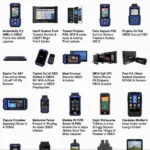A digital monitor for OBD2 is an invaluable tool for any car owner, offering a window into the heart of your vehicle’s performance and health. Gone are the days of relying solely on cryptic dashboard lights and hoping for the best. With a digital monitor plugged into your car’s OBD2 port, you unlock a wealth of real-time data, empowering you to diagnose issues, improve efficiency, and even enhance your driving experience.
Why Choose a Digital Monitor for OBD2?
The beauty of a digital monitor for OBD2 lies in its ability to translate complex vehicle data into an easily understandable format. Whether you’re a seasoned mechanic or a car enthusiast looking to delve deeper into your vehicle’s performance, a digital monitor can be your trusted co-pilot. Here’s how:
- Early Problem Detection: A digital monitor can catch minor issues before they escalate into major headaches. By monitoring parameters like engine temperature, oxygen sensor readings, and emissions data, you can identify potential problems early on.
- Cost Savings: Imagine being able to diagnose a check engine light before rushing to a mechanic. A digital monitor can provide specific trouble codes, helping you understand the issue and potentially saving you unnecessary diagnostic fees.
- Enhanced Performance: For the performance enthusiast, a digital monitor becomes an essential tool. Monitor horsepower, torque, acceleration times, and other crucial metrics, allowing you to fine-tune your car for optimal performance.
- Improved Fuel Efficiency: By keeping an eye on fuel consumption and driving habits, you can make adjustments to your driving style that promote better fuel economy and reduce your carbon footprint.
Types of Digital Monitors for OBD2
The market offers a wide array of digital monitors for OBD2, each catering to different needs and budgets. Here are some popular options:
- Basic Code Readers: These entry-level devices primarily focus on reading and clearing diagnostic trouble codes (DTCs). They are an affordable option for car owners seeking basic diagnostics.
- Bluetooth Scanners: These compact devices connect wirelessly to your smartphone or tablet, allowing you to view real-time data and perform diagnostics through user-friendly apps.
- Dedicated Scan Tools: These professional-grade devices offer advanced features like live data streaming, graphing, logging, and even bi-directional control, allowing you to interact with your vehicle’s systems.
Key Features to Consider
When choosing a digital monitor for OBD2, consider the following features:
- Compatibility: Ensure the device is compatible with your car’s make, model, and year.
- Display: Opt for a monitor with a clear, easy-to-read display, especially if you plan to use it while driving.
- Data Parameters: Check the range of data parameters the device can monitor, such as speed, RPM, engine load, coolant temperature, and fuel pressure.
- Additional Features: Some monitors offer extra features like GPS tracking, trip logging, and performance testing.
How to Use a Digital Monitor for OBD2
Using a digital monitor for OBD2 is generally straightforward:
- Locate your OBD2 port: The OBD2 port is typically located under the driver’s side dashboard.
- Connect the monitor: Plug the monitor into the OBD2 port.
- Turn on the ignition: Turn the key to the “on” position without starting the engine.
- Access the data: Use the monitor’s buttons or app interface to navigate through menus and select the data you want to view.
Expert Insight: “A digital monitor is like having a conversation with your car,” says John Smith, Senior Automotive Engineer at XYZ Auto. “It allows you to understand its language, anticipate its needs, and ensure it’s always performing at its best.”
Conclusion
A digital monitor for OBD2 is no longer just a tool for mechanics. It’s an essential device for any car owner who values transparency, control, and peace of mind. By investing in a digital monitor, you empower yourself to make informed decisions about your car’s maintenance, performance, and overall well-being.

